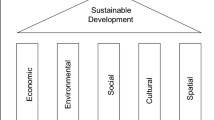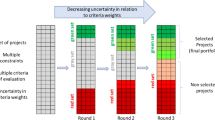Abstract
Project portfolio selection is a multi-criteria decision-making process that is always accompanied by important decisions with uncertainty. Considering the existence of different data in the field of various projects, the use of data-driven approaches to evaluate and select projects in previous studies has been neglected. To cover this gap, the purpose of this study is to provide a hybrid data-driven framework for selecting investment projects in the telecommunication industry. To do this, first by reviewing the theoretical literature and surveys of experts, project evaluation criteria through sustainability paradigm as well as strategic issues are identified, and then with the best–worst fuzzy approach (FBWM), the weight of each criterion is determined. According to the FBWM findings, the most important criteria identified include initial capital requirements, initial revenue, number of specialists employed, energy consumption reduction, and market share increase. After identifying the important criteria, using data envelopment analysis (DEA), the performance of each project was determined separately for each year. Then, based on project labels specified by DEA, the efficiency of projects is measured and evaluated with a forward-looking view through machine learning algorithms such as random forest and support vector regressors. Results show that both models can predict the project performance appropriately, while the random forest regressor has the highest evaluation metrics in both train and test sets. So, the managers could use these results for more efficient project selection.










Similar content being viewed by others
Data availability
Enquiries about data availability should be directed to the authors.
References
Abdel-Basset M, Manogaran G, Gamal A, Smarandache F (2019) A group decision making framework based on neutrosophic TOPSIS approach for smart medical device selection. J Med Syst 43:1–3. https://doi.org/10.1007/s10916-019-1156-1
Abdilahi SM, Fakunle FF, Fashina AA (2020) Exploring the extent to which project scope management processes influence the implementation of telecommunication projects. PM World J IX 9(5):1–17
Alhayani BSA (2021) Visual sensor intelligent module based image transmission in industrial manufacturing for monitoring and manipulation problems. J Intell Manuf 32(2):597–610
Alizadeh Z, Otero B M, & Jalilzadeh A (2022) An inexact variance-reduced method for stochastic quasi-variational inequality problems with an application in healthcare. ArXiv Preprint
Alyamani R, Long S (2020) The application of fuzzy Analytic Hierarchy Process in sustainable project selection. Sustainability 12(20):8314
Ardavan A, AlemTabriz A, Rabie M, Zandieh M (2019) Sustainable supplier selection based on grey theory: case study in steel industry. J Ind Eng Res Prod Syst 6(13):165–177
Awasthi A, Omrani H (2019) A goal-oriented approach based on fuzzy axiomatic design for sustainable mobility project selection. Int J Syst Sci Oper Logist 6(1):86–98
Bai L, Chen H, Gao Q, Luo W (2018) Project portfolio selection based on synergy degree of composite system. Soft Comput 22(16):5535–5545
Bektur G, Saraç T (2019) A mathematical model and heuristic algorithms for an unrelated parallel machine scheduling problem with sequence-dependent setup times, machine eligibility restrictions and a common server. Comput Oper Res 103:46–63. https://doi.org/10.1016/j.cor.2018.10.010
Boroun M, Alizadeh Z, & Jalilzadeh A (2023) Accelerated primal-dual scheme for a class of stochastic nonconvex-concave saddle point problems. ArXiv Preprint
Chawla V, Chanda A, Angra S, Chawla G (2018) The sustainable project management: a review and future possibilities. J Proj Manag 3(3):157–170
Çoban V (2020) Solar energy plant project selection with AHP decision-making method based on hesitant fuzzy linguistic evaluation. Complex Intell Syst 6(3):507–529
Conka T, Vayvay O, Sennaroglu B (2008) A combined decision model for R & D project portfolio selection. Int J Bus Innov Res 2(2):190–202
Davoudabadi R, Mousavi SM, Mohagheghi V, Vahdani B (2019) Resilient supplier selection through introducing a new interval-valued intuitionistic fuzzy evaluation and decision-making framework. Arab J Sci Eng 44(8):7351–7360
De Souza LP, Gomes CFS, De Barros AP (2018) Implementation of new hybrid AHP–TOPSIS-2N method in sorting and prioritizing of an it CAPEX project portfolio. Int J Inf Technol Decis Mak 17(04):977–1005
Eilat H, Golany B, Shtub A (2006) Constructing and evaluating balanced portfolios of R & D projects with interactions: a DEA based methodology. Eur J Oper Res 172(3):1018–1039
El Yamami A, Mansouri K, Qbadou M (2018) Multi-objective IT project selection model for improving SME strategy deployment. Int J Elect Comput Eng 8(2):1102
Fallahpour A, Olugu EU, Musa SN, Khezrimotlagh D, Wong KY (2016) An integrated model for green supplier selection under fuzzy environment: application of data envelopment analysis and genetic programming approach. Neural Comput Appl 27(3):707–725. https://doi.org/10.1007/s00521-015-1890-3
Fashina AA, Abdilahi SM, & Ibrahim A (2020) The significant factors that influence the choice of project scope management practices in telecommunication companies in Somaliland1
ForouzeshNejad AA (2023) Leagile and sustainable supplier selection problem in the Industry 40 era: a case study of the medical devices using hybrid multi-criteria decision making tool. Environ Sci Pollut Res 30(5):13418–13437
Fu S, Xiao Y, Zhou H, Liu S (2021) Venture capital project selection based on interval number grey target decision model. Soft Comput 25(6):4865–4874
Galankashi MR, Bastani Z, & Hisjam M (2021) Supplier selection : a lean-agile ( Leagile ) Approach. 2391–2402
Ghapanchi AH, Tavana M, Khakbaz MH, Low G (2012) A methodology for selecting portfolios of projects with interactions and under uncertainty. Int J Project Manage 30(7):791–803
Górecka D (2013) Multi-criteria decision aiding in project management-outranking approach and verbal decision analysis. Studia Ekonomiczne 137:11–38
Guo S, Zhao H (2017) Fuzzy best-worst multi-criteria decision-making method and its applications. Knowl-Based Syst 121:23–31. https://doi.org/10.1016/j.knosys.2017.01.010
Guo Y, Wang L, Li S, Chen Z, Cheng Y (2018) Balancing strategic contributions and financial returns: a project portfolio selection model under uncertainty. Soft Comput 22(16):5547–5559
Hashemi SH, Karimi A, Tavana M (2015) An integrated green supplier selection approach with analytic network process and improved Grey relational analysis. Int J Prod Econ 159:178–191
Hocine A, Kouaissah N, Bettahar S, Benbouziane M (2018) Optimizing renewable energy portfolios under uncertainty: a multi-segment fuzzy goal programming approach. Renewable Energy 129:540–552
Irannezhad M, Shokouhyar S, Ahmadi S, Papageorgiou EI (2021) An integrated FCM-FBWM approach to assess and manage the readiness for blockchain incorporation in the supply chain. Appl Soft Comput 112:107832
Jafarzadeh H, Akbari P, Abedin B (2018) A methodology for project portfolio selection under criteria prioritisation, uncertainty and projects interdependency–combination of fuzzy QFD and DEA. Expert Syst Appl 110:237–249
Jurík L, Horňáková N, Šantavá E, Cagáňová D, & Sablik J (2020) Application of AHP method for project selection in the context of sustainable development. Wireless networks, 1–10
Kudratova S, Huang X, Zhou X (2018) Sustainable project selection: optimal project selection considering sustainability under reinvestment strategy. J Clean Prod 203:469–481
Leung M-F, Wang J (2022) Cardinality-constrained portfolio selection based on collaborative neurodynamic optimization. Neural Netw 145:68–79
Liu C (2020) Research on project management of coastal engineering enterprises under a nonparametric DEA production function. J Coast Res 108:246–249
Ma J, Harstvedt JD, Jaradat R, Smith B (2020) Sustainability driven multi-criteria project portfolio selection under uncertain decision-making environment. Comput Ind Eng 140:106236
Mahmoudi A, Deng X, Javed SA, Zhang N (2020) Sustainable supplier selection in megaprojects: grey ordinal priority approach. Bus Strategy Environ. https://doi.org/10.1002/bse.2623
Mahmoudi A, Deng X, Javed SA, Yuan J (2021) Large-scale multiple criteria decision-making with missing values: project selection through TOPSIS-OPA. J Ambient Intell Humaniz Comput 12(10):9341–9362
Mohagheghi V, Mousavi SM, Antuchevičienė J, Dorfeshan Y (2019) Sustainable infrastructure project selection by a new group decision-making framework introducing MORAS method in an interval type 2 fuzzy environment. Int J Strateg Prop Manag 23(6):390–404
Mosavi A, Ozturk P, Chau K (2018) Flood prediction using machine learning models: literature review. Water 10(11):1536
Narang M, Joshi MC, Bisht K, Pal A (2022) Stock portfolio selection using a new decision-making approach based on the integration of fuzzy CoCoSo with Heronian mean operator. Decis Mak Appl Manag Eng 5(1):90–112
Pan Y, Zhang L (2021) A BIM-data mining integrated digital twin framework for advanced project management. Autom Constr 124:103564
Pedrosa N, Montoni L, Martens CDP, Da Silva LF, Da Cunha JC (2022) Absorptive capacity in information technology projects: a multiple case study in the telecommunication industry. Int J Proj Organ Manag 14(1):36–64
Pramanik D, Haldar A, Mondal SC, Naskar SK, Ray A (2017) Resilient supplier selection using AHP-TOPSIS-QFD under a fuzzy environment. Int J Manag Sci Eng Manag 12(1):45–54. https://doi.org/10.1080/17509653.2015.1101719
Ridha HM, Gomes C, Hizam H, Ahmadipour M, Heidari AA, Chen H (2021) Multi-objective optimization and multi-criteria decision-making methods for optimal design of standalone photovoltaic system: A comprehensive review. Renew Sustain Energy Rev 135:110202
Rostami O, Tavakoli M, Tajally A, GhanavatiNejad M (2023) A goal programming-based fuzzy best–worst method for the viable supplier selection problem: a case study. Soft Comput 27(6):2827–2852
San Cristóbal JR, Carral L, Diaz E, Fraguela JA, & Iglesias G (2018) Complexity and project management: a general overview. complexity
Sazvar Z, Tavakoli M, Ghanavati Nejad M, & Nayeri S (2022) Sustainable-resilient supplier evaluation for high-consumption drugs during COVID-19 pandemic using a data-driven decision-making approach. Scientia iranica
Shaygan A, Testik ÖM (2019) A fuzzy AHP-based methodology for project prioritization and selection. Soft Comput 23(4):1309–1319
Stanitsas M, Kirytopoulos K, Leopoulos V (2021) Integrating sustainability indicators into project management: the case of construction industry. J Clean Prod 279:123774
Tavakoli M, Tavakkoli-Moghaddam R, Mesbahi R, Ghanavati-Nejad M, Tajally A (2022) Simulation of the COVID-19 patient flow and investigation of the future patient arrival using a time-series prediction model: a real-case study. Med Biol Eng Compu 60(4):969–990
Tavakoli, M., Torabi, S. A., GhanavatiNejad, M., & Nayeri, S. (2023). An integrated decision-making framework for selecting the best strategies of water resources management in pandemic emergencies. Scientia Iranica.
Tiryaki F, Ahlatcioglu B (2009) Fuzzy portfolio selection using fuzzy analytic hierarchy process. Inf Sci 179(1–2):53–69
Toloo M, Mirbolouki M (2019) A new project selection method using data envelopment analysis. Comput Ind Eng 138:106119
Wang JW, Cheng CH, Huang KC (2009) Fuzzy hierarchical TOPSIS for supplier selection. Appl Soft Comput J 9(1):377–386. https://doi.org/10.1016/j.asoc.2008.04.014
Wu C, Wu P, Wang J, Jiang R, Chen M, Wang X (2021) Critical review of data-driven decision-making in bridge operation and maintenance. Struct Infrastruct Eng 18(1):47–70
Yalcin AS, Kilic HS, & Guler E (2019) Research and development project selection via IF-DEMATEL and IF-TOPSIS. International Conference on Intelligent and Fuzzy Systems, pp 625–633
Yan S, Ji X (2018) Portfolio selection model of oil projects under uncertain environment. Soft Comput 22(17):5725–5734
You P, Guo S, Zhao H, Zhao H (2017) Operation performance evaluation of power grid enterprise using a hybrid BWM-TOPSIS method. Sustainability 9(12):2329
Zhang W, Wu C, Li Y, Wang L, Samui P (2021) Assessment of pile drivability using random forest regression and multivariate adaptive regression splines. Georisk Assess Manag Risk Eng Syst Geohazards 15(1):27–40
Funding
The authors have not disclosed any funding.
Author information
Authors and Affiliations
Corresponding author
Ethics declarations
Conflict of interest
The authors have not disclosed any competing interests.
Additional information
Publisher's Note
Springer Nature remains neutral with regard to jurisdictional claims in published maps and institutional affiliations.
Rights and permissions
Springer Nature or its licensor (e.g. a society or other partner) holds exclusive rights to this article under a publishing agreement with the author(s) or other rightsholder(s); author self-archiving of the accepted manuscript version of this article is solely governed by the terms of such publishing agreement and applicable law.
About this article
Cite this article
ForouzeshNejad, A. A hybrid data-driven model for project portfolio selection problem based on sustainability and strategic dimensions: a case study of the telecommunication industry. Soft Comput 28, 2409–2429 (2024). https://doi.org/10.1007/s00500-023-08445-w
Accepted:
Published:
Issue Date:
DOI: https://doi.org/10.1007/s00500-023-08445-w




